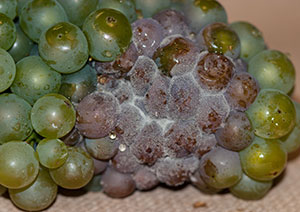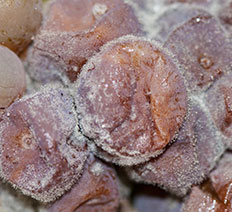Botrytis Bunch Rot of Grape
Botrytis bunch rot, caused by the fungus Botrytis cinerea, is a common problem wherever grapes are grown. The disease can cause serious losses in both yield and quality when weather conditions favour the disease.
Symptoms:
Ripening grapes are affected by a rot which may progress to infect whole clusters. With sufficient rain and humidity, berries develop a greyish mold on the surface. Affected berries may shrivel in the dry Okanagan climate.
Botrytis may cause girdling lesions on the pedicel or rachis, leading to drying of clusters or portions of clusters, and premature cluster drop. Botrytis also causes post-harvest rot of table grapes.
 |
 |
| Bunch rot of grape cluster caused by Botrytis cinerea. Note light grey sporulation of the fungus on infected berries. | |
Infection and Spread:
Overwintering and early season infection: Botrytis overwinters in plant debris and mummified fruit as sclerotia and mycelium, both on the ground and on canes. In the spring, conidia (spores) are produced which can infect flowers, shoots, leaves and fruit. The overwintered debris with the highest sporulation potential is the mummified fruit, followed by the fruit rachids, then tendrils, canes and leaf litter.
There are 2 types of early season infection:
- Latent Infection of flower parts leads to fruit infections that remain dormant in early summer. As fruit ripens and berries begin to soften, the fungus becomes active again, causing rot
- Botrytis is a very good colonizer of dead and dying plant tissue. Infected flower remnants & aborted fruit that become trapped in clusters become sources of fruit infection as bunches close and ripen.
Late Season Infection: Fruit infection usually begins in berries with 5 to 8 percent sugar (at veraison), with berries remaining susceptible up to harvest and also post-harvest. Fruit become increasingly susceptible has they mature. Abundant conidia are produced on infected fruit, leading to secondary spread to adjacent berries in a cluster and to nearby clusters. Rot spreads quickly in compact clusters where maturing berries are compressed together. Spread of the spores is aided by wind, summer rains, overhead irrigation, heavy dew and juice from split berries. Fruit damage caused by birds, insects, hail, sunscald and powdery mildew creates entry points for the fungus and can greatly increase losses due to bunch rot. Grape cultivars with dense canopies, thin skins, and/or tight clusters are more susceptible to botrytis bunch rot.
Weather factors: Botrytis conidia can germinate and infect between 1-30 °C. However infection conditions are optimal at 15-20 oC with moisture or high humidity over 90%..
Table 1. Time/temperature relationships for botrytis bunch rot infection
| Temperature | Amount of Time |
| 10 oC | 30 hours or more |
| 15.5 oC | 18 hours or more |
| 22.5 oC | 15 hours or more |
| 26.5 oC | 22 hours or more |
| 30 oC | 35 hours or more |
Slow drying conditions together with high humidity (90% or better) favour the development of Botrytis. Table 1 indicates the temperature required plus the corresponding period that slow drying conditions must exist for bunch rot infection to occur.
Cultural Control of Botrytis Bunch Rot:
During the growing season:
- Avoid overhead irrigation and keep irrigation periods as short as possible.
- Prevent excessive vine growth by judicious use of water and fertilizer.
- Canopy management, including shoot thinning and leaf removal before fruit set will reduce botrytis bunch rot. Remove leaves and lateral shoots located opposite, one node above, and one node below each fruit cluster.
- Prevent berry damage by effective control of powdery mildew early in the growing season.
- Minimize berry damage by birds and insects.
During the dormant season:
- Reduce carry-over of botrytis to the next season by removing any remaining fruit from the vines during pruning. If practical, remove trash from the vineyard floor.
Table 2. Susceptibility of grape varieties in British Columbia to botrytis bunch rot
|
Very Susceptible |
Susceptible |
Moderately Susceptible |
Least Susceptible |
|
Auxerrois |
Barbera |
Ortega |
Cabernet Franc |
Chemical Control of Botrytis Bunch Rot:
Several fungicides are registered for the control or suppression of botrytis bunch rot (See Table 3). Alternate fungicides from different chemical groups to help prevent the development of resistance.
Key timings for Botrytis fungicide applications are bloom, just before bunch closing, veraison and pre-harvest. Botrytis control becomes more difficult as the grapevine matures because heavy canopy growth and bunch closing make it difficult to place the fungicide where it is needed.
The number of spray applications necessary to control bunch rot depends upon disease pressure in the vineyard and weather conditions, as well as other factors such as susceptibility. Fewer applications may be needed if weather is very dry and/or disease pressure is low. Use a full program in vineyards where bunch rot was a serious problem in the previous year, and where sanitation measures were not taken after harvest. The number of sprays can be reduced in vineyards with a history of low disease levels and for all vineyards in dry years.
Under typical Okanagan weather patterns, high risk periods for Botrytis infection are during bloom and from 1 to 2 weeks after veraison to harvest. These growth stages often coincide with rainy periods during June and September.
Table 3. Fungicides registered for bunch rot control on grape
| Fungicide | Chemical Group1 |
Active ingredients | Rate/ha | Rate/acre | PHI2 (days) | Comments |
| Rovral | 2 | iprodione 50% | 1.5 kg/ha | 600 g/acre | 7 |
Maximum 2 sprays/season
|
| Elevate | 17 | fenhexamid 50% | 1.12 kg/ha | 450 g/acre | 7 |
Maximum 3 sprays/season
|
| Pristine | 7+11 |
pyraclostrobin 12.8% + boscalid 25.2% |
420 – 735 g/ha | 170-300 g/acre | 14 |
Registered as suppression only for botrytis bunch rot. Maximum 2 sprays/season. Wine grapes only.
|
| Kenja | 7 | isofetamid | 1.46-1.61 L/ha | 591-652 mL/acre | 14 | Maximum 3 sprays/season |
| Luna Tranquility | 7+9 | fluopyram 125 g/L +pyrimethanil 375 g/L | 1.2 L/ha | 485 mL/acre | 7 |
Maximum 2 sprays per season. Wine grapes only.
|
| Scala | 9 | pyrimethanil 400g/L | 2.0 L/ha | 810 mL/acre | 7 |
Maximum 3 sprays/season
|
| Vangard | 9 | cyprodinil 75% | 750 g/ha | 300 g/acre | 7 |
Maximum 2 sprays/season
|
| Switch | 9+12 | cyprodinil 37.5% +fludioxonil 25% | 775-975 g/ha | 314-395 g/acre | 7 |
Maximum 2 spays/season
|
| Serenade MAX | 44 | Bacillus subtilis | 3-6 kg/ha | 1.2-2.4 kg/acre | 0 |
Biofungicide. Disease suppression only.
|
| Regalia Maxx | P | Reynoutria sachalinensis | 0.25% solution (2.5 L/1000 L water) | 0 | Biofungicide. Disease suppression only. Works by host plant defence induction. | |
| Fracture | NC | BLAD polypeptide | 1.5-3.3 L/ha | 0.6-1.3 L/acre | 0 | Biofungicide. Use higher rate for high disease pressure. |
| Botector | NC | Aureobasidium pullulans | 400 g/ha | 162 g/acre | 0 | Biofungicide. Suppression only. Sensitive to some fungicides - see label. |
1Chemical Group: Products with the same number belong to the same class of compounds. Alternate products with different chemical groups to help delay or prevent the development of resistance. NC= not classified.
2Pre-harvest Interval - time interval between last application and harvest
Be cautious about adding spreaders or stickers to fungicide sprays, as some spray adjuvants have been shown to increase the development of bunch rot on grape clusters. It is believed that spray adjuvants remove the natural wax protection on grape berries.
Additional Information on Botrytis
Guide to registered fungicides, insecticides and herbicides for use on commercial grape crops:
